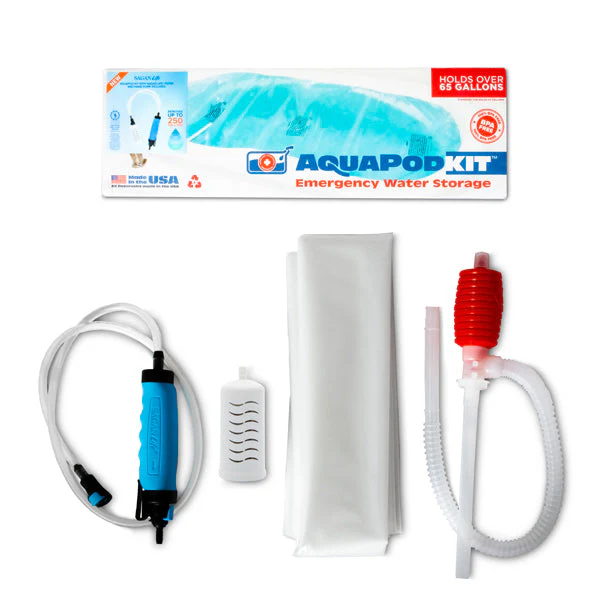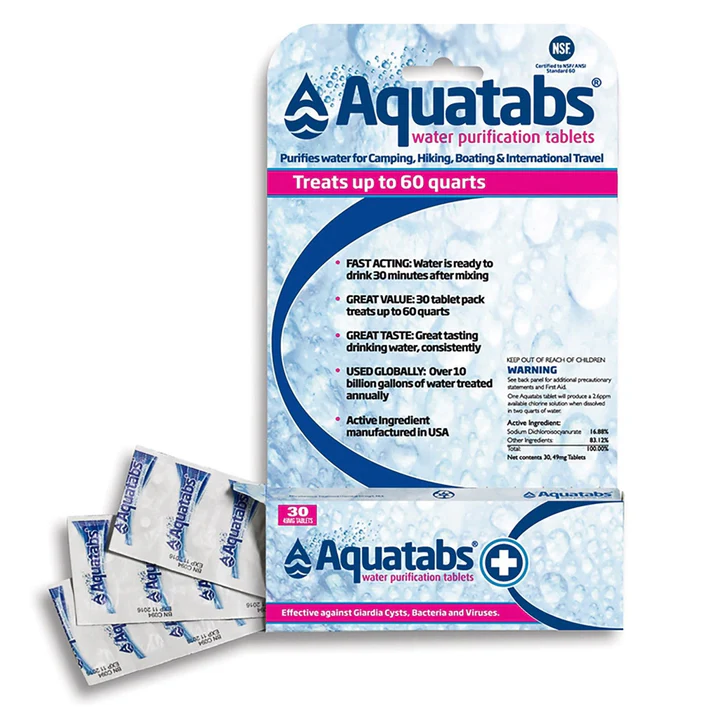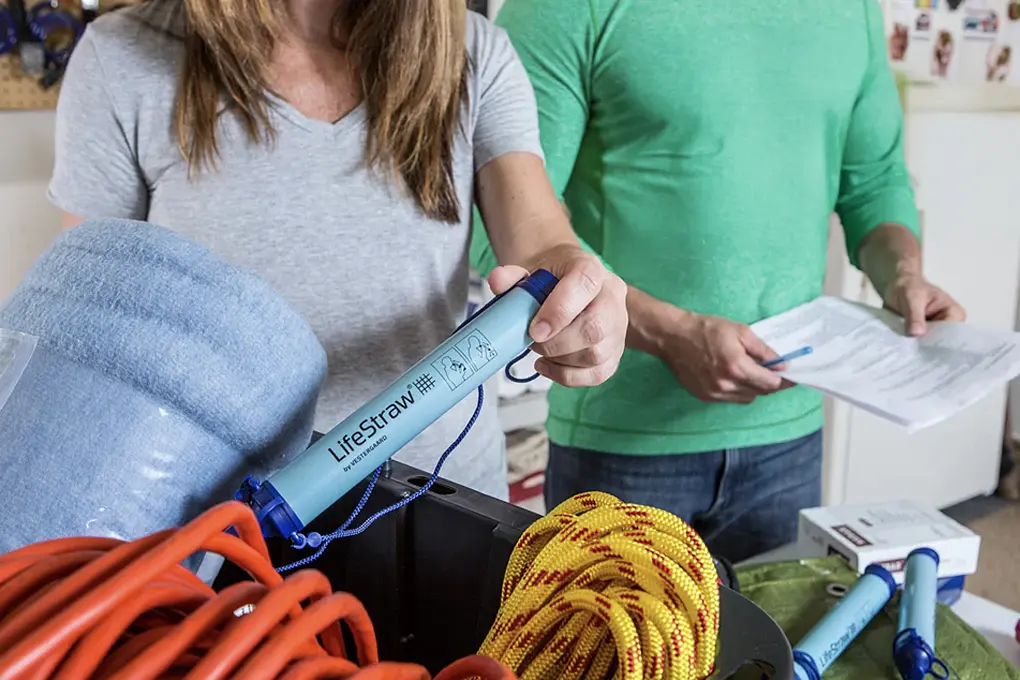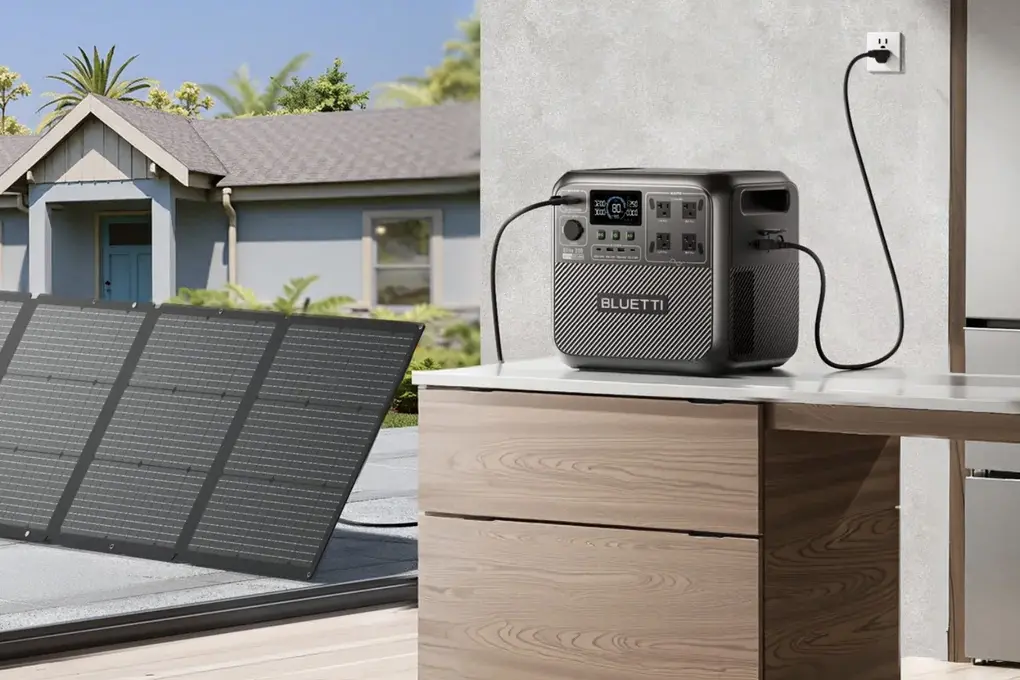Quick Answer: The best water filters for emergency preparedness combine storage, filtration, and purification to keep drinking water safe during disasters. Systems like bathtub reservoirs, portable filters, and chemical tablets protect against bacteria, viruses, and chemicals when power outages or contamination make tap water unsafe to drink.
Clean, safe water is one of the first things people lose access to during an emergency. The best water filters for emergency preparedness protect you from that risk by turning unsafe or contaminated water into something you can safely drink. This guide highlights the top filters designed for reliability, portability, and long-term use when clean water matters most.
Table of Contents
- Key Takeaways
- What Makes Emergency Water Filtration Different?
- Disaster Water Threats Families Face
- Aquapod Tub Filter Kit: Best for Hurricane and Storm Warning
- Sagan AquaBrick Water Purification System: Premium Family Solution
- LifeStraw Personal Water Purifier: Portable Evacuation Essential
- Personal Water Filter Straw: Budget-Friendly Backup
- AQUATABS Water Tablets: Lightweight Chemical Backup
- Feature Comparison: Emergency Water Filters
- Choosing the Right Filter for Your Disaster Scenario
- Building Complete Water Preparedness
- Frequently Asked Questions
- Sources
Key Takeaways
- Effective emergency water preparedness requires multi-layer protection including storage, mechanical filtration, and chemical purification to handle different disaster conditions and contaminants.
- Biological contaminants such as E. coli, Giardia, and rotavirus are common after floods, while wildfire ash and damaged infrastructure can release heavy metals and toxins into water systems.
- Filters using activated carbon and nano-fiber technology remove chemicals and microorganisms, while chemical tablets add vital virus protection that mechanical filters alone cannot achieve.
- For short-term emergencies, portable filters and purification tablets provide immediate water access, while long-term plans should include larger storage and multi-stage filtration for households.
- Shop Batten’s Emergency Water Collection for durable, tested water storage systems, portable purifiers, and purification tablets trusted for family and disaster readiness.
What Makes Emergency Water Filtration Different?
Municipal water supplies fail during disasters.
- Hurricane Ida left 441,000 Louisiana residents under boil-water advisories for weeks.
- Texas winter storms in 2021 contaminated systems serving 14.9 million people.
- California wildfires compromise watersheds with ash and debris, forcing treatment plant shutdowns.
Standard home filters can’t handle contaminated floodwater, sediment-heavy creek water, or bacteria-laden emergency sources.
Emergency filtration removes biological threats – bacteria, viruses, protozoan parasites – that cause severe illness when tap water becomes unsafe. These systems work without electricity during extended outages affecting refrigeration, lighting, and water pumps simultaneously.
Disaster Water Threats Families Face
When disaster strikes, safe drinking water becomes one of the first essentials to disappear. Floods, storms, and infrastructure failures all expose families to serious waterborne threats. To choose the best water filters for emergency preparedness, it’s critical to understand what you’re filtering out and why different contaminants require specific filtration technologies.
Biological Contaminants
Floodwater and surface runoff often carry harmful microorganisms from sewage systems, animal waste, and decaying organic matter. Common pathogens include E. coli, Salmonella, Giardia, Cryptosporidium, and viruses such as hepatitis A and rotavirus.
These cause severe gastrointestinal illnesses that can quickly become life-threatening when medical services are disrupted.
For reference, bacteria range from 0.5 to 3.0 microns, protozoan cysts from 4 to 20 microns, and viruses from 0.02 to 0.3 microns.
Filters rated at 0.2 microns or smaller remove most bacteria and protozoa, but viruses require additional treatment such as chemical purification or UV sterilization. Comprehensive emergency filters often combine mechanical filtration with UV or iodine systems to ensure complete microbial protection.
Chemical and Sediment Challenges
Chemical contamination is just as dangerous but less visible. Floodwater can carry pesticides, petroleum products, and cleaning solvents from nearby properties, while wildfires release ash, heavy metals, and carcinogens into groundwater.
Damaged infrastructure can leach lead, chromium, and arsenic into household plumbing when water pressure drops or fluctuates.
Turbid or muddy water also shortens filter lifespan by clogging pores. Using a pre-filter such as a coffee filter, fine cloth, or gravity settling container helps extend filter performance. For chemical safety, activated carbon and ion exchange media are essential.
These absorb or neutralize industrial pollutants, volatile organic compounds, and bad tastes that simple hollow-fiber filters cannot handle.
Emergency filters with multi-stage systems – combining sediment removal, activated carbon, and chemical treatment – offer the most reliable protection when dealing with contaminated or unpredictable water sources after a disaster.
Aquapod Tub Filter Kit: Best for Hurricane and Storm Warning
The Aquapod transforms standard bathtubs into 65-gallon emergency reservoirs during advance-warning disasters. Food-grade LLDPE liner protects water from soap residue and debris, keeping supplies fresh for 8+ weeks when municipal systems fail.

Aquapod Tub Filter Kit at a Glance
- Price: $74.95 (as of October 2025)
- Capacity: 65 gallons (260 liters) stored
- Filter: Journey Filter treats 250 gallons
- Fill Time: 10-15 minutes with standard faucet
- Best For: Families with advance warning (hurricanes, winter storms)
- Buy: Available on Batten Shop
The kit includes disposable bladder, Journey Water Filter using nano-fiber technology, and hand pump for dispensing.
The filter removes bacteria, viruses, and protozoan cysts through electroadsorption rather than mechanical filtration – effective against contaminants as small as viruses without requiring tiny pores that clog quickly.
How Bathtub Storage Works
Place the liner in the tub, secure the fill port over the faucet, and fill within a couple inches of rim (never overfill).
A standard tub holds 70 gallons; Aquapod recommends 65-gallon maximum to avoid exceeding floor load limits. Water stored in open tub spoils within days from dust, bacteria, and soap film – but the bladder prevents this contamination.
Pros and Cons
Pros
- Stores 65 gallons without dedicated space (uses existing bathtub)
- Made in USA with HACCP-certified, BPA-free materials
- Replacement liners available for reuse (pump and filter last multiple uses)
Cons
- Requires advance warning to fill (not suitable for sudden disasters like earthquakes)
- Limits bathtub use during storage period
- Disposable liner creates waste (though recyclable as #4 plastic)
Sagan AquaBrick Water Purification System: Premium Family Solution
AquaBrick combines 3-gallon stackable storage containers with pressurized DuraFlo filtration, treating 700 gallons of contaminated water. The system handles swimming pool water (500 gallons), creek water, and flood runoff – versatility missing from single-purpose filters.

Sagan AquaBrick at a Glance
- Price: $149.99 complete kit (as of October 2025)
- Capacity: 3 gallons storage, 700 gallons filtration
- Flow Rate: 0.5 gallon per minute (30 gallons hourly)
- Construction: BPA-free HDPE, watertight and crushproof
- Best For: Families wanting storage plus purification capability
- Buy: Available on Batten Shop
DuraFlo filter uses nano-fiber technology removing 99.9999% bacteria, 99.99% viruses, 99.99% protozoan cysts. Independent labs test filters until “end of life” – This is actual capacity verification rather than theoretical estimates. The filter handles turbid water better than hollow-fiber designs that clog rapidly.
Using the AquaBrick System
- Fill the container with untreated water from any non-salt source.
- Attach DuraFlo filter, hand pump, and spigot to cap.
- Insert filter tube into water, screw cap tight, pressurize with hand pump.
- Open spigot and purified water flows into bottles, pots, or drinking glasses.
Containers stack in multiple configurations, fitting basement shelves or garage storage. Each brick holds 3 gallons water or 20 pounds dry food – this dual-purpose design reduces the need for dedicated emergency storage space. The carry handle enables transport during evacuations.
Pros and Cons
Pros
- Treats pool water, flood water, and natural sources (not just municipal supply)
- Stackable containers organize efficiently (vertical storage saves floor space)
- Lifetime warranty on containers, 700-gallon filter capacity verified by independent testing
Cons
- Higher upfront cost than basic straw filters ($150 vs $20-30)
- Requires manual pumping (not gravity-fed like Berkey systems)
- 3-gallon capacity requires multiple fills for large families
LifeStraw Personal Water Purifier: Portable Evacuation Essential
LifeStraw’s hollow-fiber membrane filter provides 1,000 gallons (4,000 liters) capacity in a 9-inch straw weighing 2 ounces. Unlimited shelf life means decades of storage without degradation – critical for bug-out bags assembled years before actual use.

LifeStraw Personal at a Glance
- Price: $19.95 (as of October 2025)
- Capacity: 1,000 gallons (4,000 liters)
- Weight: 2 ounces
- Dimensions: 9 inches long, 1 inch diameter
- Best For: Bug-out bags, individual evacuation, vehicle kits
- Buy: Available on Batten Shop
This filter removes 99.999999% bacteria, 99.999% parasites, 99.999% microplastics. It does NOT remove viruses – acceptable for North American backcountry water but risky for flood water or international disasters where viral contamination occurs. Pair it with chemical treatment for complete protection.
How to Use LifeStraw
Drink directly from water sources (streams, puddles, containers) by placing the filter end in water and sucking through the mouthpiece. No batteries, no pumping, no setup.
Backwash after use by blowing air through the filter to clear debris and maintain flow rate.
That said, the straw design limits versatility, as you cannot fill bottles for later use, attach to hydration bladders, or share among groups efficiently. Each person needs an individual LifeStraw for simultaneous water access. Consider multi-pack for families (4-pack available for $69.95).
Pros and Cons
Pros
- Ultra-portable (2 ounces fits pockets, glove compartments, first-aid kits)
- No expiration date or shelf life (ready decades after purchase)
- Simple operation requires no training (even children use successfully)
Cons
- Straw-only design prevents filling bottles (limits mobility during hiking evacuations)
- Does not remove viruses (pair with Aquatabs for complete protection)
- Individual units needed per person (cannot efficiently share among groups)
Personal Water Filter Straw: Budget-Friendly Backup
Generic filter straws like this, using 0.1-micron hollow-fiber membranes cost under $10 while matching LifeStraw’s bacteria and parasite removal. The shorter 7-inch length improves packability in crowded bug-out bags where every inch matters.

Personal Filter Straw at a Glance
- Price: $8.95 (as of October 2025)
- Capacity: 1,000+ gallons typical
- Filter Size: 0.1 microns (smaller than LifeStraw’s 0.2)
- Length: 6-7 inches (varies by brand)
- Best For: Vehicle kits, backup filters, budget-conscious families
- Buy: Available on Batten Shop
Membrane Solutions and similar brands copy the LifeStraw design but offer tighter 0.1-micron filtration at a fraction of cost. Testing shows comparable performance for bacteria and protozoan removal. It lacks LifeStraw’s brand recognition and extensive field testing, but meets basic emergency needs.
Pros and Cons
Pros
- Budget pricing ($9 vs $20 for LifeStraw) enables multiple backups
- Shorter length (7 inches vs 9) improves packability in tight spaces
- Tighter filtration (0.1 micron vs 0.2) captures smaller particles
Cons
- Less field testing than LifeStraw (brand launched 2005 with extensive humanitarian use)
- Variable quality between brands (research specific model reviews)
- Does not remove viruses (same limitation as LifeStraw)
AQUATABS Water Tablets: Lightweight Chemical Backup
Chemical purification treats viruses that mechanical filters miss. AQUATABS use sodium dichloroisocyanurate releasing a controlled hypochlorous acid dosage to clean water – EPA-registered, NSF-certified chemistry eliminating biological threats in 30 minutes.

AQUATABS 30-Count at a Glance
- Price: $12.95 for 30 tablets (as of October 2025)
- Capacity: 60 quarts treated (2 quarts per tablet)
- Treatment Time: 30 minutes contact time
- Weight: Under 1 ounce for 30 tablets
- Best For: Bug-out bags, international travel, virus protection
- Buy: Available on Batten Shop
Each 49mg tablet treats 2 quarts of clear water or 0.8 quarts of turbid water. It removes 99.9999% bacteria, 99.99% viruses, 99.9% cysts (Giardia). These individually foil-wrapped tablets remain effective for years – expiration is typically 5+ years from manufacture.
How Chemical Treatment Works
Drop the tablet in a water container, shake or stir until dissolved (10 minutes), wait 30 minutes before drinking. Chlorine residual prevents recontamination for 3-5 days in closed containers – useful for pre-treating stored water.

Turbid water requires pre-filtration through cloth or settling – sediment harbors organisms hidden from chemical contact. Pair AQUATABS with LifeStraw: filter removes sediment and improves taste, tablets eliminate viruses that straw filters miss.
Pros and Cons
Pros
- Removes viruses mechanical filters cannot (essential for flood water, international disasters)
- Weighs under 1 ounce per 30 tablets (negligible pack weight for hikers)
- No taste or odor unlike iodine tablets (more palatable during extended use)
Cons
- Requires 30-minute wait before drinking (mechanical filters provide instant access)
- Ineffective against Cryptosporidium (requires filtration or extended contact time)
- Dosage varies with water clarity (confusing instructions for beginners)
Feature Comparison: Emergency Water Filters
| Feature | Aquapod Kit | AquaBrick | LifeStraw | Filter Straw | AQUATABS |
| Price | $74.95 | $149.99 | $19.95 | $8.95 | $12.95 |
| Capacity | 250 gal filter | 700 gal filter | 1,000 gal | 1,000 gal | 60 quarts |
| Removes Viruses | Yes | Yes | No | No | Yes |
| Portability | Fixed location | Stackable | Pocket-sized | Pocket-sized | Ultra-light |
| Electricity | None | Hand pump | None | None | None |
| Best For | Storm warning | Family use | Evacuation | Budget backup | Virus protection |
Choosing the Right Filter for Your Disaster Scenario
Different disasters require different water filtration strategies. Your choice depends on warning time, contamination type, and access to storage or transport. The following situations highlight which systems perform best in specific emergencies.
Hurricane and Advance-Warning Disasters
When a storm is forecasted, storing clean water before impact is critical. The Aquapod Tub Filter Kit can hold up to 65 gallons, providing several weeks of safe drinking water for an average family.
Fill the bladder 24-48 hours before the storm to secure a reliable supply during power outages or potential contamination events. This setup works well for hurricanes, winter storms, or planned water shutoffs where there is time to prepare.
Earthquake and No-Warning Emergencies
Earthquakes and similar sudden disasters demand portable, ready-to-use filtration. Keep a LifeStraw in your vehicle, an AquaBrick system in your home, and AQUATABS in your emergency bag.
These tools allow you to treat water immediately without setup or electricity. A combination of pre-filled containers and mobile filtration ensures safe water even when infrastructure fails without warning.
Flood and Wildfire Contamination
Floods and wildfires introduce hazardous chemicals and heavy metals into water sources. These require filters equipped with activated carbon.
The AquaBrick DuraFlo Filter removes not only bacteria but also pesticides, petroleum products, and heavy metals, making it effective for post-disaster contamination.
The Aquapod is suitable for clean tap water storage before contamination but should not be used for collecting floodwater or runoff.
Extended Power Outages
During long blackouts, water utilities may lose pressure or stop pumping altogether. Bathtub storage systems like the Aquapod provide an immediate supply when power fails.
If outages last longer than a week, switch to an AquaBrick or similar gravity-fed system to purify natural or stagnant sources such as ponds, pools, or low-pressure tap water.
Evacuation and Bug-Out Scenarios
For evacuation, prioritize lightweight gear. A LifeStraw (2 ounces) paired with AQUATABS (1 ounce) offers mechanical filtration and virus protection for over 1,000 gallons while weighing under three ounces.
Skip bulky storage containers and focus on portable systems that treat water found along your route. This combination provides compact, reliable hydration for on-foot evacuations or vehicle-based travel.
Ready to protect your family with reliable water filtration? Browse Batten’s emergency water collection for bathtub storage systems, portable purifiers, and backup treatment tablets trusted by emergency managers.
Building Complete Water Preparedness
A reliable emergency water plan combines multiple tools and methods. No single filter or system can handle every situation, so layering your approach ensures long-term safety and flexibility when water access is disrupted.
Start by securing a short-term supply for the first few days after a disaster. Lightweight filters and chemical tablets can provide immediate drinking water during evacuations or power outages. Next, invest in larger storage and purification systems capable of treating household volumes for extended shelter-in-place situations.
Regular testing and familiarity are key. Practice using your filters, sanitize your storage containers, and confirm that all equipment functions correctly before an emergency. Keep essential supplies accessible in vehicles and near exit points for quick response when time matters most.
Get prepared today with Batten’s Emergency Water Collection, featuring trusted solutions for safe water storage, filtration, and purification during any crisis.
Frequently Asked Questions
Do Emergency Water Filters Remove Viruses?
Only certain systems remove viruses. Chemical treatments like iodine or chlorine tablets and nano-fiber filters in pressurized systems can eliminate viruses effectively. Basic hollow-fiber filters, such as most straw-style models, remove bacteria and parasites but not viruses. In North America, natural water sources usually pose low viral risk, but floodwater, sewage-contaminated, or international sources require full purification.
How Long Do Water Filters Last During Disasters?
Filter lifespan depends on the model and water quality. Most portable filters last for several hundred to a thousand gallons of use, which equals several years for one person. Chemical tablets usually remain effective for at least five years. Filters processing sediment-heavy or cloudy water clog faster than those used with clear sources, reducing overall capacity.
Can I Use Pool Water for Drinking?
You can drink pool water only after proper filtration and chemical treatment. Filters with activated carbon reduce chlorine and other pool chemicals, but heavy shock treatments require the water to sit uncovered for at least 24 hours before filtering. Never drink untreated pool water since chemical levels can cause illness even when it appears clean.
What’s the Difference Between Filtration and Purification?
Filtration removes physical contaminants such as dirt, bacteria, and parasites through mechanical barriers. Purification eliminates viruses and other biological threats using chemical disinfectants or advanced filtration systems. According to the EPA, filters target bacteria and protozoa, while purifiers also neutralize viruses – making purification essential for floodwater or international emergencies.
How Much Water Does My Family Need?
FEMA recommends storing at least one gallon of water per person per day for drinking and hygiene. A family of four needs about 12 gallons for three days or 84 gallons for a week. Hot weather, children, illness, or pregnancy increase these needs. Store at least a three-day supply, and plan for two weeks when possible, supported by filtration for additional safety.
Sources
- Backer, H. D., Derlet, R. W., & Hill, V. R. (2019). Wilderness Medical Society Clinical Practice Guidelines for Water Disinfection for Wilderness, International Travel, and Austere Situations. Wilderness & Environmental Medicine, 30(4 Suppl), S100–S120. U.S. National Library of Medicine / PubMed Central. https://www.ncbi.nlm.nih.gov/pmc/articles/PMC10961709/
- Coulson, M. (2024). The Visible and Unseen Dangers Lurking in Floodwater. Johns Hopkins Bloomberg School of Public Health. https://publichealth.jhu.edu/2024/the-visible-and-unseen-dangers-lurking-in-floodwater
- McGill, K., & Reeves, J. (2021). Louisiana Residents Face Power Outages, Water Shortages After Hurricane Ida. PBS NewsHour / Associated Press. https://www.pbs.org/newshour/nation/louisiana-residents-face-power-outages-water-shortages-after-hurricane-ida
- Houston Advanced Research Center (HARC). (2021). Winter Storm Uri’s Impacts & Pathways to Resilience in Texas: Water Supply Impacts. Houston Advanced Research Center (HARC). https://harcresearch.org/project/winter-storm-uri-impacts-and-pathways-to-resilience-in-texas
- “Water Filter Performance Testing Results,” 2025, Water Filter Guru, https://waterfilterguru.com/best-emergency-water-filter/
- “Portable Water Filter Reviews,” July 2025, The Prepared, https://theprepared.com/gear/reviews/portable-water-filters/
- “AquaPod Emergency Water Storage System,” February 2025, Sagan Life, https://saganlife.com/product/aquapod-emergency-water-filtration-system/
- “AquaBrick Water Purification System Specifications,” March 2025, Sagan Life, https://saganlife.com/product/aquabrick-water-purification-system/
- “LifeStraw Personal Water Filter,” 2025, LifeStraw, https://lifestraw.com/products/lifestraw
- “AQUATABS Water Purification Tablets,” August 2025, AQUATABS US, https://www.aquatabs.us/product/aquatabs-49mg-tablets/




